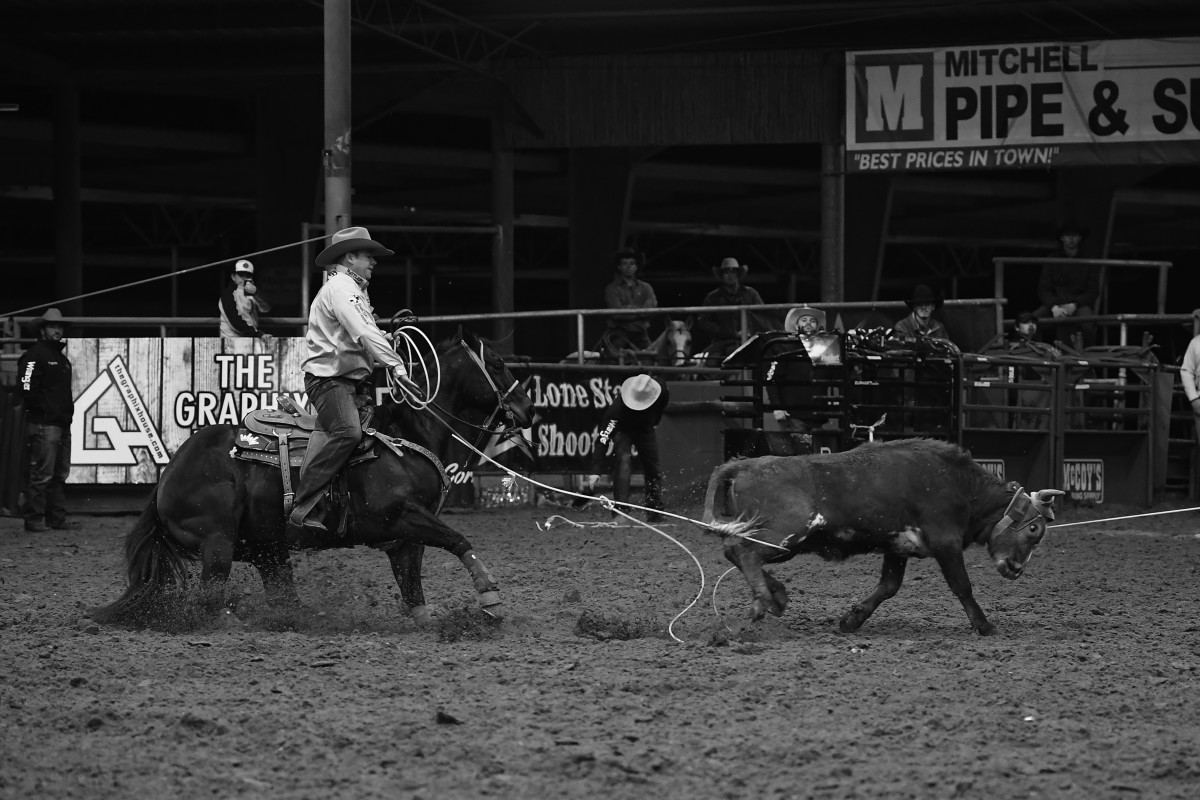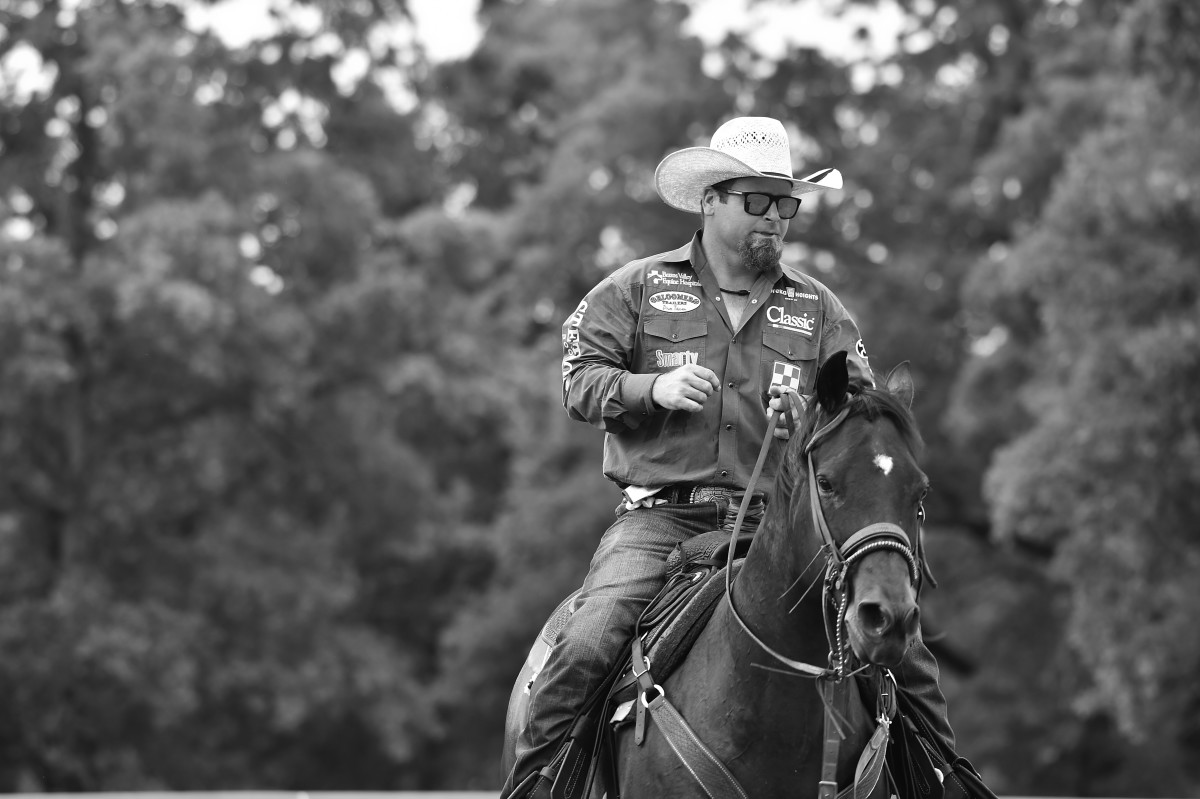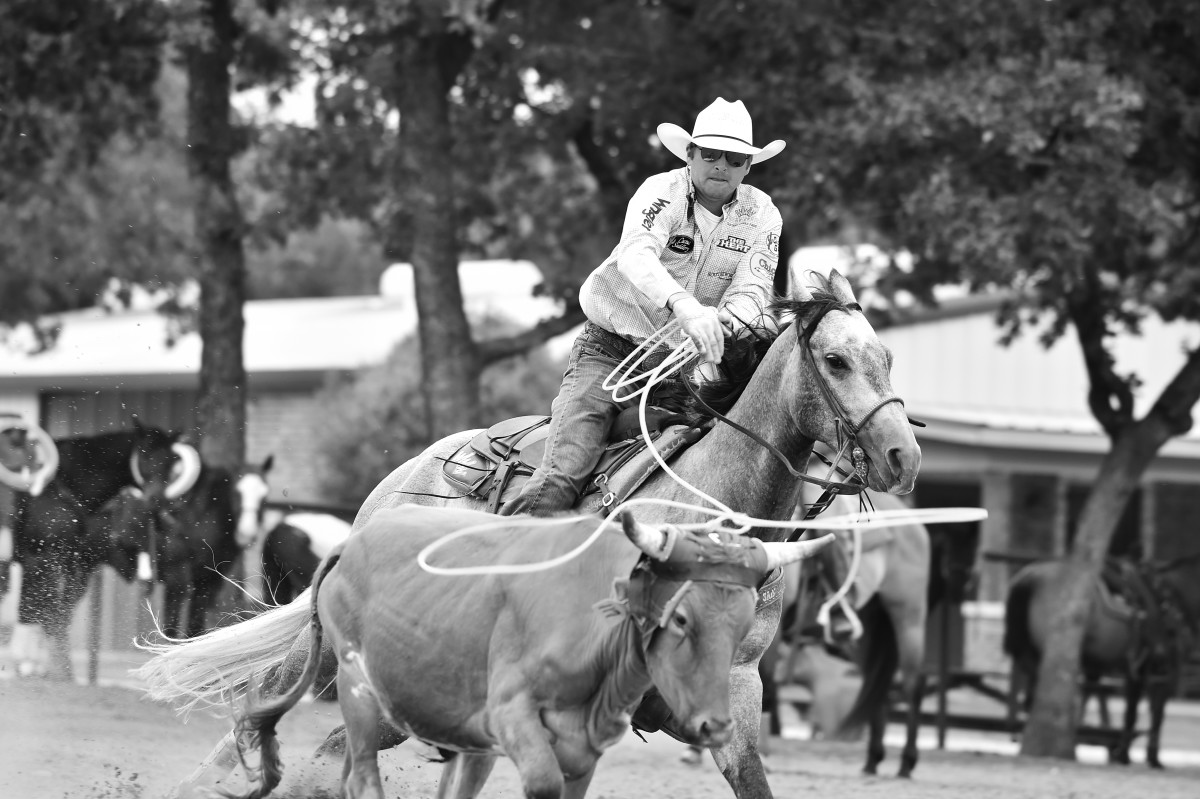Do rope horses really need tie-downs?
You want every little advantage when the money’s up. So why not tweak your headgear until it helps your horse perform its absolute best?
Here are the pros’ takes on the types of tie-downs they like and why.
Types of Tie-Downs for Rope Horses
First, a run-down on the different nuances. A traditional tie-down keeps the nose in a relatively tucked position, thereby encouraging the horse to collect the rest of its body. Also available are versions with browbands instead of nosebands. The theory with a browband tie-down is that a horse will stand up and keep its shoulders up better because it won’t lean into a browband as easily as it will a noseband.
A browband tie-down differs from a bonnet, which has sliding rings that distribute pressure to both the brow and poll. Also called a headsetter, it’s typically made of small-diameter rope or nylon. Poll pressure typically encourages horses to lower their heads vertically. Thus, a bonnet, in theory, allows a horse to extend his nose more than it can with a tie-down. Extension of the nose is mechanically necessary for a horse to run and for balance. But collection is also crucial. It’s a fine line.
What you’ll find available from companies like Martin Saddlery or Cactus’ Relentless line are nosebands made of straight leather, cord, single rope, and double rope covered with leather, rawhide, or nylon, plus straps made of leather or a material called Biothane. The latter is stronger and holds up better than leather to temperature fluctuations and sweat-soaked roping sessions, but is less forgiving for the horse than leather.
No matter what you start using, trainers recommend you prepare your horse first. Adjust the strap snug enough for a horse to feel it and send the horse around a round pen. You never want to surprise a horse with any kind of headgear.

Favorite materials
It might seem that a tie-down is a tie-down is a tie-down. But subtle variations in materials can mean big differences in your horse’s performance. Nosebands made of flat latigo leather are recommended for younger or more green rope horses, while several pros favor the even pressure distributed by rigid nosebands.
Oklahoma’s Travis Graves, who along with Kory Koontz is the only pro heeler who won all four big jackpots—the BFI, the George Strait Classic, the Wildfire and the US Open—has earned millions of dollars on horses sporting a rawhide noseband.
“I use a two-strand rope noseband covered in rawhide,” said Graves, who’s been to 12 NFRs and won the average in Vegas in 2017. “Honestly, I use that on a lot of my horses. I leave the strap a bit longer. If my horse ever hits that noseband, he knows it. So I don’t need it as tight.”
TG says the perfect tie-down is even more crucial for headers in the box because they “need a good flat go.” That’s obviously what his partner Dustin Egusquiza gets, considering he’s been throwing from the scoreline most of the season. For headers, your tie-down has a lot to do with your horse’s speed and elevation leaving the corner. That’s the same point the “King of the Cowboys” made in this magazine in April. Trevor Brazile says the box is where head horses most want to evade pressure. Like TG, he prefers a rope noseband.
“If that leather is too comfortable, horses get used to bracing against it,” believes Brazile. “They’ll get stiff in their shoulders and start stopping on their front ends or taking jerks on their front ends. Then they get sore from the way they’re taking jerks or logging a steer’s weight.”
Brazile designed his Relentless leather-covered rope noseband with a smaller-diameter rope using less crowns so it’s less rigid.
“They know they hit the end of it, but it doesn’t bite them unless they’re really wanting to test it,” he said.
A fan of the same leather-covered rope-nose gear is 2019 NFR average champion Cody Snow. He wants a tie-down that his horse won’t lean on, but that won’t pinch or bite. Another fan is Caleb Smidt, who annually wins enough with his head rope to finish near the top of the PRCA’s all-around heap. The two-time world champion calf roper, 31, bases his noseband choice on how strong his horse is running. If his head horse is trying to run through his throw, that’s when Smidt ditches a leather noseband for rawhide. He switches back and forth on his calf horses, too.

“I really think it’s about the combination of bit and noseband,” he added. “If a horse wants to duck, I’d say use a heavy bit and lighter tie-down, whereas if he really wants to pull on you and run free, maybe use the tougher tie-down. With a real light-mouthed horse that wants to really run, maybe go with a ranker tie-down and lighter bit.”
Another rope-nose fan is former world champion header Aaron Tsinigine. He uses that on his tough old bay, Little Brother, because with leather, the horse doesn’t feel like he’s really in Tsinigine’s hand. But on Smudge, his super-broke gold-buckle bay, a rope noseband was too much so he wore leather.
Also using a leather-covered rope-nose tie-down this summer was Tate Kirchenschlager, a header who got on a heater in early July to jump into the PRCA’s Top 15. He uses one that Monty Joe Petska made out of a piggin’ string.
Strap length
Like Graves, Kirchenschlager pairs a longer strap with his harder noseband.
“I don’t like to use a tie-down as a crutch,” he said. “I think if it’s too short, it messes up a horse’s stride. And I think horses get to pushing and leaning and don’t respect a leather noseband. I don’t want a rough noseband that makes them bleed, but enough they’ll stay off it and not get numb to it like they do leather.”
Graves’ horse, Chip, is a former reined cow-horse that’s super broke, so that’s another reason a longer strap works for him. Strap length depends, he said, on how broke your horse is and how he carries his head when he travels. But beware of a strap too tight.
“You don’t want your horse’s head tied down so much that it can’t get its hind end down,” he said. “A horse needs to elevate its front end to get those hind legs underneath it to stop.”
The right headgear provides “freedom with boundaries,” according to Brazile, so your horse’s headset is balanced leaving the box. A strap too tight can cause your horse to brace with his shoulders as he learns to push on it, and that leads to shoulder and back soreness.
Arguably one of the best-scoring headers on the road, Snow says he likes a middle-of-the-road adjustment so a horse hits it if he throws his nose up, but doesn’t feel tied down.
“A tight strap can limit how a horse strides out—and that can be a good thing on a horse that’s too free,” said Snow. “But even then, it should be temporary so you don’t use it as a crutch. And a too-long strap lets a horse get its head up and hollow its back, so then it can’t leave the corner as hard. Think about how you get ready to start a race—not all sprawled out but tucked in and collected.”

Choices choices
The pros suggest starting with a basic leather noseband and going from there. What you do want is your horse to perform with smooth motion at his prime athletic capability. What you don’t want is your horse flipping his head up or hollowing his back when you apply bit pressure.
A tie-down gives you the advantage if your horse pulls on your hand. And, as Smidt mentioned, a tougher noseband can be used instead of a bigger bit. Rope or rawhide nosebands help if you want more control, but don’t want your horse to back off or slow down.
As far as type, a tie-down is called for if a horse is pushing its nose out too far, or a bonnet is more in order if the nose is tucked but the head is just up too high. Bonnets can also come in handy if a horse is climbing or running “up” instead of forward. Tsinigine resorted to a bonnet with his palomino whenever Yeller was running off a little bit.
“I made it myself by cutting off the tail of an old ranch rope,” he said. “When my horse got too strong, I used that bonnet to get control. But it’s bad horsemanship if you rely on that.”
Sometimes a bonnet gives a horse more freedom via the unrestricted nose, but you’ll still have ample control to keep his hind end underneath him. To reiterate, if a horse elevates his head too much in the run, you lose control of his body. But if his nose is tied down too tight, he will feel like he can’t move his feet.
Ryan Motes, a 20-year veteran, BFI champ and world-record holder, mostly uses leather nosebands and long straps because his horses are cutting-broke. But something harder is in order “sometimes, when you’re trying to go fast and not get too much extra slide, or when you’re coming into the corner and need your horse to be able to shut down fast,” he said.
Rawhide can chew up a horse’s nose, he added, so it should only be used if a horse really needs it for balance.
“I don’t want to slow a horse down, but give one something to brace against to stop if need be,” he explained. “It’s more for balance. If you tie their head down too much, they tend to swing their hips around as they’re stopping, especially if you’re throwing fast. Horses have to get their heads up to get their hind end down. I switch between Martin’s regular leather and double-rope, leather-covered nosebands.”
Some horses won’t stretch out and run into a tie-down, but still need help balancing. That’s where a leather noseband comes in, or even a bonnet that allows them to push against something but still extend their nose to run. And some horses have psychological issues with feeling tied down. For instance, when world champ Cory Petska first started roping on his ace sorrel, Chumley, he was traveling with his head so low that it made him front-endy.

“He’d just drop his front end into the ground, driving your tip into the ground,” Petska recalled. “One day we were practicing and I completely took off the tie-down. He worked amazing. The next morning at the jackpot, with a tie-down on again, he worked terrible. I took it off the next day and never put one back on him.”
Petska assumes Chumley went too many years in a too-tight rope-nose tie-down. Get this—Chumley drops his front end even with just the noseband and no strap snapped on! That doesn’t mean Petska isn’t a believer in tie-downs. Heck, if he gets on a horse that acts chargey, he’ll use a rawhide noseband. But his usual go-to is leather with his favorite Petska bit. Cory’s parents imparted a load of headgear wisdom to him, for which he’s grateful.
These days, Petska has Chumley showing off that gold-buckle form that everyone is ironically trying to achieve with tie-downs. That’s how important it is to adjust one correctly—so it’s not in your horse’s way. After all, Chumley already knows how to do his job, Petska says, and it’s his job to “literally leave him alone.”











